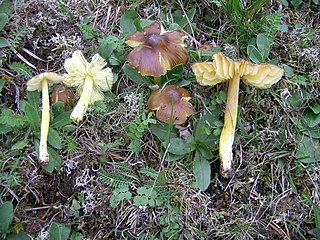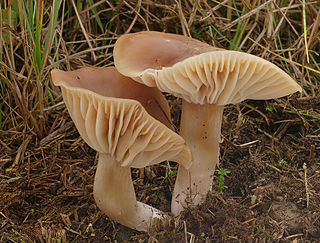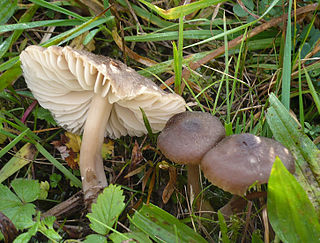
Hygrocybe punicea is a species of agaric in the family Hygrophoraceae. It has been given the recommended English name of crimson waxcap. The species has a European distribution, occurring mainly in agriculturally unimproved grassland. Threats to its habitat have resulted in the species being assessed as globally "vulnerable" on the IUCN Red List of Threatened Species. Records of H. punicea from North America, East Asia, and Australia require further research to see if they represent the same species.

Geoglossaceae is a family of fungi in the order Geoglossales, class Geoglossomycetes. These fungi are broadly known as earth tongues. The ascocarps of most species in the family Geoglossaceae are terrestrial and are generally small, dark in color, and club-shaped with a height of 2–8 cm. The ascospores are typically light-brown to dark-brown and are often multiseptate. Other species of fungi have been known to parasitize ascocarps. The use of a compound microscope is needed for accurate identification.

Entoloma bloxamii, commonly known as the midnight blue entoloma, or big blue pinkgill, is a species of agaric in the family Entolomataceae. The species has a European distribution, occurring mainly in agriculturally unimproved grassland. Entoloma bloxamii has been reported from North America, but at least some of these reports represent a distinct species, Entoloma medianox. Threats to its habitat have resulted in the Big Blue Pinkgill being assessed as globally "vulnerable" on the IUCN Red List of Threatened Species.

Trichoglossum hirsutum is a species of fungus in the family Geoglossaceae. In the UK, it has been given the recommended English name of hairy earthtongue. In North America it is known variously as velvety earth tongue, shaggy earth tongue, or black earth tongue. DNA evidence suggests the hairy earthtongue may be a species complex.

Glutinoglossum glutinosum, commonly known as the viscid black earth tongue or the glutinous earthtongue, is a species of fungus in the family Geoglossaceae. Widely distributed in the Northern Hemisphere, it has been found in northern Africa, Asia, Europe, and North America. Although previously thought to exist in Australasia, collections made from these locations have since been referred to new species. G. glutinosum is a saprophytic species that grows on soil in moss or in grassy areas. The smooth, nearly black, club-shaped fruitbodies grow to heights ranging from 1.5 to 5 cm. The head is up to 0.7 cm (0.3 in) long, and the stipes are sticky. Several other black earth tongue species are quite similar in external appearance, and many can be reliably distinguished only by examining differences in microscopic characteristics, such as spores, asci, and paraphyses. First described in 1796 as a species of Geoglossum, the fungus has gone through several changes of genera in its taxonomic history. It was placed in its current genus, Glutinoglossum, in 2013.

Microglossum is a genus of fungi in the family Leotiaceae. Ascocarps occur in soil and resemble earth tongues, but are microscopically distinct. Microglossum atropurpureum, a species typical of waxcap grassland in Europe, is of global conservation concern and is listed as "vulnerable" on the IUCN Red List of Threatened Species.

Microglossum atropurpureum is a species of fungus in the family Leotiaceae. In the UK, it has been given the recommended English name of dark-purple earthtongue. Ascocarps are black, often with a purple tint, and are irregularly club-shaped. They occur in soil and resemble earth tongues, but are microscopically distinct. The species was formerly referred to the genus Geoglossum, but is not closely related to the Geoglossomycetes.

Gliophorus europerplexus is a species of agaric in the family Hygrophoraceae. It has been given the recommended English name of butterscotch waxcap. The species has a European distribution, occurring mainly in agriculturally unimproved grassland. Threats to its habitat have resulted in the species being assessed as globally "vulnerable" on the IUCN Red List of Threatened Species.

Gliophorus reginae is a species of agaric in the family Hygrophoraceae. It has been given the recommended English name of jubilee waxcap. The species has a European distribution, occurring mainly in agriculturally unimproved grassland. Threats to its habitat have resulted in the species being assessed as globally "vulnerable" on the IUCN Red List of Threatened Species.

Neohygrocybe ingrata is a species of agaric in the family Hygrophoraceae. It has been given the recommended English name of dingy waxcap. The species has a European distribution, occurring mainly in agriculturally unimproved grassland. Threats to its habitat have resulted in the species being assessed as globally "vulnerable" on the IUCN Red List of Threatened Species.

Hygrocybe spadicea is a species of agaric in the family Hygrophoraceae. It has been given the recommended English name of Date Waxcap. The species has a European distribution, occurring mainly in agriculturally unimproved grassland. Threats to its habitat have resulted in the species being assessed as globally "vulnerable" on the IUCN Red List of Threatened Species.

Cuphophyllus colemannianus is a species of agaric in the family Hygrophoraceae. It has been given the recommended English name of toasted waxcap. The species has a European distribution, occurring mainly in agriculturally unimproved grassland. Threats to its habitat have resulted in the species being assessed as globally "vulnerable" on the IUCN Red List of Threatened Species.

Cuphophyllus lacmus is a species of agaric in the family Hygrophoraceae. It has been given the recommended English name of grey waxcap. The species has a European distribution, occurring mainly in agriculturally unimproved grassland. Threats to its habitat have resulted in the species being assessed as globally "vulnerable" on the IUCN Red List of Threatened Species.

Neohygrocybe nitrata is a species of agaric in the family Hygrophoraceae. It has been given the recommended English name of nitrous waxcap, based on its smell. The species has a European distribution, occurring mainly in agriculturally unimproved grassland. Threats to its habitat have resulted in the species being assessed as globally "vulnerable" on the IUCN Red List of Threatened Species.

Entoloma porphyrophaeum is a species of agaric in the family Entolomataceae. It has been given the recommended English name of Lilac Pinkgill. The species has a European distribution, occurring mainly in agriculturally unimproved grassland. Entoloma porphyrophaeum has been reported from North America, but at least some of these reports represent a distinct species, Entoloma canadense. Threats to its habitat have resulted in the Lilac Pinkgill being assessed as globally "vulnerable" on the IUCN Red List of Threatened Species.

Entoloma prunuloides is a species of agaric in the family Entolomataceae. It has been given the recommended English name of Mealy Pinkgill, based on its distinctive smell. The species has a European distribution, occurring mainly in agriculturally unimproved grassland. Threats to its habitat have resulted in the Mealy Pinkgill being assessed as globally "vulnerable" on the IUCN Red List of Threatened Species.

Entoloma griseocyaneum is a species of agaric in the family Entolomataceae. It has been given the recommended English name of Felted Pinkgill. The species has a European distribution, occurring mainly in agriculturally unimproved grassland. Threats to its habitat have resulted in the Felted Pinkgill being assessed as globally "vulnerable" on the IUCN Red List of Threatened Species.

Cuphophyllus atlanticus is a species of agaric in the family Hygrophoraceae. Until recently (2021), the species was considered to be conspecific with the North American Cuphophyllus canescens, but DNA sequencing has shown that it is distinct. As C. canescens, it has been given the recommended English name of felted waxcap in the United Kingdom. Cuphophyllus atlanticus has a European and North American distribution, occurring in Europe mainly in agriculturally unimproved grassland. Threats to its habitat have resulted in C. canescens being assessed as globally "vulnerable" on the IUCN Red List of Threatened Species.
Pseudotricholoma metapodium is a species of agaric in the family Tricholomataceae. It has been given the recommended English name of mealy meadowcap. The species has a European distribution, occurring mainly in agriculturally unimproved grassland. Threats to its habitat have resulted in the mealy meadowcap being assessed as globally "endangered" on the IUCN Red List of Threatened Species.
Cuphophyllus lepidopus is a species of agaric in the family Hygrophoraceae. It has been given the recommended English name of scalyfoot waxcap. The species has a European distribution, occurring mainly in agriculturally unimproved grassland. Threats to its habitat have resulted in the species being assessed as globally "vulnerable" on the IUCN Red List of Threatened Species.



















